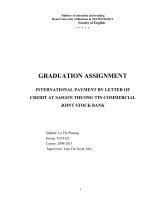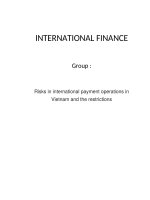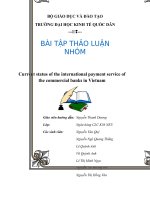International payment
Bạn đang xem bản rút gọn của tài liệu. Xem và tải ngay bản đầy đủ của tài liệu tại đây (72.18 KB, 7 trang )
INTERNATIONAL PAYMENT
I. INTRODUCTION TO INTERNATIONAL PAYMENT
International trade credit and the documents associated with it are more complicated
than their domestic equivalents. This is because international trade cuts across two
bodies of laws and regulations and because the buyers and sellers ure less familiar
with and less accessible to one another than buyers and sellers in the same country.
These complications often require the help of banks to: intermediate import-export
transactions through methods of international payment.
In the simplest form of international trade, the open-account basis, banks have only a
simple transaction role. In open-account trade, the importer and exporter are wellknown to each other and probably have established a successful working relationship.
The importer orders goods and promptly pays for them when the goods and tittles
thereto are received. Almost as simple is the foreign collection basis, in which a bank
is used to transmit collected funds. Before the goods it has bought can be shipped, the
importer must place funds with its bank so that the exporter is assured that payment
will be made with collected funds. In this instance, the bank is merely an agent and
not a lender.
II. PAYMENT INSTRUMENTS
1. Bill of exchange
A written, unconditional order by one party, the drawer, to another, the drawee, to
pay a certain sum, either immediately (a sight bill) or on a fixed date, a term bill, for
payment of goods and/or services received. The drawee accepts the bill by signing it,
thus converting it into a post-dated check and a binding contract. A bill of exchange is
also called a draft but, while all drafts are negotiable instruments, only to order bills of
exchange can be negotiated.
According to the 1930 Convention Providing A Uniform Law for Bills of Exchange
and Promissory Notes held in Geneva, a bill of exchange contains: (i) The term bill of
exchange inserted in the body of the instrument and expressed in the language
employed in drawing up the instrument. (ii) An unconditional order to pay a
determinate sum of money, (iii) The name of the person who is to pay, drawee, (iv) A
statement of the time of payment. (v) A statement of the place where payment is to be
made. (vi) The name of the person to whom or to whose order payment is to be made.
(vii) A statement of the date and of the place where the bill is issued. (vili) The
signature of the person who issues the bill, drawer. A bill of exchange is the most
often used form of payment in local and international trade and has a long history-as
long as that of writing.
2. Promissory notes
A promissory note is a written, signed, unconditional and unsecured promise by one
party to another that commits the maker to pay a specified sum on demand, or on a
fixed or a determinable date. Promissory notes such as bank or currency notes are
negotiable instruments.
3. Cheque
A cheque is an order by the account holder to withdraw funds from his account, either
in cash or through or through payment to another party. Cheques provide both safety
and convenience. A cheque is a non-cash payment instrument, ie, customers do not
need to carry large amounts of cash with them, which is easy to be lost or stolen
In addition, a cheque is only valid when it is signed by the account holder and is
secured by a cheque card so your money can not be withdrawn from your account if
someone finds your cheque book. Using cheques is convenient because they are easy
to use. The account holder can draw a cheque anywhere without going to the bank
such as in shops, supermarkets, restaurants, hotels and so on.
When drawing a cheque, it is obligatory to complete all. The drawer must writes
cheques in ink and avoid as much blank as possible for fraudulence and use the ruler
to cross out any blanks In the case of the blank cheque book being used, all the
cheques need to be crossed, with 'not negotiable. If the cheque is corrected of charged,
the drawer must initial the correction in addition to his usual signature. In effect, a
cheque presented will be honoured if there is enough money in the drawer's account
Different types of cheque book are supplied to account holders free of charge
according to their requirements either with or without stubs, bearer or order. crossed
or uncrossed. Cheque books can be sent to an account holder by registered post, or
may be given to him at the counter against his signes receipt. Cheque books are
considered security documents in view of danger of their misuse by people trying to
commit fraud.
4. Transfer
Transfer is an order by the account holder to withdraw funds from his account to pay
for another party, or transfer the funds to his other account. This can be conducted via
Mail, Telegraphic or Electronic transfer.
5. Bank cards
Bank cards are bank-issued card with a magnetic stripe that holds machine readable
identification code. Bank cards are used for electronic commerce with magnetic stripe
or via the internet and or banking transactions automatic teller machines Two main
types of bank cards are credit and debit cards
Credit cards are a means of exchange, not of payment. Ultimate payment by the card
user occurs at the end of the month when a cheque is written or a bank account is
debited to settle the outstanding balance. In that respect, credit cards are akin to trade
credit for the users, and a substitute credit long extended by retailers to customers.
However, to the seller of goods, sales made to the credit card users have similarities to
those made to cheque writers. Costs and fee may differ, but credit card sales vouchers
can be effectively credited to the merchant's bank account in a similar manner to
cheque received. Because the voucher is a claim on the credit card company or issuing
bank, the risk of nonpayment is lower
In the ways that most are currently structured, credit card systems can be thought of
as similar to the cheque payments system. Paper (i.e. vouchers) flows in a similar
direction, the major difference being the timing of transactions and liabilities incurred
along the way. The card holder voucher writer is given short-term credit (a short-term
loan or long-term float) by the card issuing body between the linediate unconditional
credit to the merchant involved and delay collection of value from the card holder.
The combination of flost to card holders and more or less immediate reimbursement to
stores is thought to be one factor inhibiting the greater use of the EFTPOS system, in
which fleat is absent.
6. Letters of credits
Letters of credit (LCs) are one of the most versatile and secure instruments available
to international traders. An LC is a commitment by a bank on behalf of the importer,
foreign buyer, that payment will be made to the beneficiary, exporter, provided that
the terms and conditions stated in the LC have been met, as evidenced by the
presentation of specified documents.
Since LCs are credit instruments, the importer's credit with his bank is used to obtain
an LC. The importer pays his bank a fee to render this service. An LC is useful when
reliable credit information about a foreign buyer is difficult to obtain or if the foreign
buyer's credit is unacceptable, but the exporter is satisfied with the creditworthiness of
the importer's bank. This method also protects the importer since the documents
required to trigger payment provide evidence that goods have been shipped as agreed.
However, because LCs have opportunities for discrepancies, which may negate
payment to the exporter, documents should be prepared by trained professionals or
outsourced Discrepant documents, literally not having an 'I dotted and t crossed, may
negate the bank's payment obligation.
a) Characteristics of a letter of credit
The method is recommended for use in higher-risk situations or new or less
established trade relationships when the exporter is satisfied with the creditworthiness
of the buyer's bank. The risk is spread between exporter and importer, provided that
all terms and conditions as specified in the LC are adhered to. The payment is made
after shipment. Also, a variety of payment, financing and risk mitigation options are
available. However, it is a labor intensive process and a relatively expensive method
in terms of transaction costs.
b) Key Points
(1) An LC, also referred to as a documentary credit, is a contractual
agreement whereby the issuing bank, importer's bank, acting on behalf of its customer,
the importer or buyer, promises to make payment to the beneficiary or exporter
against the receipt of 'complying stipulated documents. The issuing bank will
typically use intermediary banks to facilitate the transaction and make payment to
the exporter. (ii) Besides, the LC is a separate contract from the sales contract on
which it is based; therefore, the banks are not concerned with the quality of the
underlying goods or whether each party fulfills the terms of the sales contract.
(iii)Next, the bank's obligation to pay is solely conditioned upon the seller's
compliance with the terms and conditions of the LC. In LC transactions, banks deal in
documents only. not goods. (iv) Also, LCs can be arranged easily for one-time
transactions between the exporter and importer or used for an ongoing series of
transactions. (v) Finally unless the conditions of the LC state otherwise, it is always
irrevocable, which means the document may not be changed or cancelled unless the
importer, banks, and exporter agree.
e) Confirmed letter of credit
A greater degree of protection is afforded to the exporter when an LC issued by a
foreign bank, the importer's issuing bank, is confirmed by a U.S. bank. The exporter
asks its customer to have the issuing bank authorize a bank in the exporter's country to
confirm this bank is typically the advising bank, which then becomes the confirming
bank. Confirmation means that the U.S. bank adds its engagement to pay the exporter
to that of the foreign bank. If an LC is not confirmed, the exporter is subject to the
payment risk of the foreign bank and the political risk of the importing country.
Exporters should consider getting confirmed LCs if they are concerned about the
credit standing of the foreign bank or when they are operating in a high-risk market,
where political upheaval, economic collapse, devaluation or exchange controls could
put the payment at risk. Exporters should also consider getting confirmed 1.Cs when
importers are asking for extended payment terms.
d) Illustrative letter of credit transaction
(1) The importer arranges for the issuing bank to open an LC in favor of the exporter.
(ii) The issuing bank transmits the LC to the nominated bank, which forwards it to the
exporter, (iii) The exporter forwards the goods and documents tor a freight forwarder.
(iv) The freight forwarder dispatches the goods and either the dispatcher or the
exporter submits documents to the nominated bank. (v) The nominated bank checks
documents for compliance with the LC and collects payment from the issuing bank for
the exporter. (vi) The importer's account at the issuing bank is debited. (vii) The
issuing bank releases documents to the importes to claim the goods from the carrier
and to clear them at customs.
e) Special letters of credit
LCS can take many forms. When an LC is made transferable, the payment obligation
under the original LC can be transferred to one or more second beneficiaries'. With a
revolving LC, the issuing bank restores the credit to its original amount each time it is
drawn down. A standby LC is not intended to serve as the means of payment for
goods but can be drawn in the event of a contractual default, including the failure of
an importer to pay invoices when due. Similarly, standby LCs are often posted by
exporters in favor of an importer to pay invoices when due. Standby LCs are often
posted by exporters in favor of importers because they can serve as bid bonds,
performance bonds, and advance payment guarantees In addition, stand-by LCs are
often used as counter guarantees against the provision of down payments and progress
payments on the part of foreign buyers.









